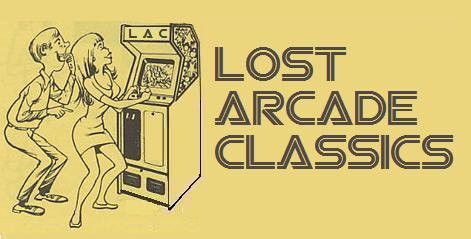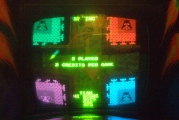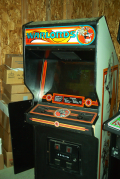

During my college years, I was all about collecting classic game consoles. Colecovision, Intellivision, the Vectrex, and of course, anything Atari related. Thrift stores, yard sales, and flea markets were my hunting grounds every weekend, and I nearly always returned home with some new treasure that I paid next to nothing for.
Very quickly the word of my growing collection spread, and soon my place was a favorite destination for old school gaming fun. A couple of times a month, my buddies Alan, Jack, Arnab and I would play several hours of classic titles, which typically wrapped up with a battle royale on the Atari 2600 for Warlords supremacy. We were the best of friends until the game commenced. Then the taunts, profanity, and disparaging comments began. Between us, Warlords earned the nickname of “the Friendship Killer”. (but not seriously!)
You’re probably wondering why the heck I’m discussing a home console game. Well, unbeknownst to most gamers, that Atari 2600 cartridge is actually a port of a failed coin-op, which was ALSO an Atari creation! Thus, Warlords fully qualifies for Lost Arcade Classic status.
Warlords presents the tale of four warring kings that have unwisely built their castles on the corners of a single square plot of land. Someone really should have been fired over at the medieval civil planning department for this effrontery!
Upon discovering their neighbors, the kings declared an all out war against each other, which is probably the only time these four monarchs have agreed on anything. Trouble is… they needed a really strong weapon to penetrate the stone walls of the castles. To borrow the title of a Bruce Lee film… “Enter the Dragon”.
As if on cue, a dragon entered the airspace of the four castles, flew around for a few seconds, then launched a single fireball. The dragon quickly exited the area, and the fireball sailed toward its intended target.
 Apparently, this sort of thing must be a fairly common occurrence in this land, as all four castles were equipped with movable shields, strong enough to deflect any oncoming fireballs. Perhaps this demonstrates an early use of asbestos? Well, whatever they were constructed of, those fireproof shields glided in front of the exposed walls of each castle, and stood as the only defense against the airborne flames. If a fireball slipped past a shield and contacted a castle, a chunk of wall would be destroyed, and the fireball would ricochet off in another direction.
Apparently, this sort of thing must be a fairly common occurrence in this land, as all four castles were equipped with movable shields, strong enough to deflect any oncoming fireballs. Perhaps this demonstrates an early use of asbestos? Well, whatever they were constructed of, those fireproof shields glided in front of the exposed walls of each castle, and stood as the only defense against the airborne flames. If a fireball slipped past a shield and contacted a castle, a chunk of wall would be destroyed, and the fireball would ricochet off in another direction.
Shields also had the unusual ability to grab a fireball, reposition themselves, and re-launch the devastating weapon toward an opposing castle. However, the shield commander needed to release that giant ball of flaming gas quickly, lest it burn holes in the very castle wall he was charged with protecting!
The degree of damage incurred when a fireball contacts a wall depended upon the fireball’s speed and angle at which it hits the structure. Eventually, a castle’s walls would be damaged enough to expose the monarch seated inside. The shield commander needed to be extra-vigilant now, because once a fireball contacted his king, the castle is defeated, and the both the king and shield would disappear.
After the destruction of a castle, a second fireball would spontaneously generate from the debris, which created double the danger in the kingdom’s airspace. The abandoned castle’s remaining walls stood for the duration of the battle, and continued to breakdown and deflect the fireball with each hit. Additional fireballs will also magically generate if the battle lasted for a while WITHOUT a castle falling.
Sure sounds like they faced a classic “damned if you do, damned if you don’t” situation to me.
And the battle raged on. The fireball sailed through the air, as each shield commander simultaneously protected their own castle, and searched for vulnerabilities in their opponent’s defenses.
He whom successfully defended his castle and king from total destruction, and remained alive after the other three kings have been defeated, was declared the victor. The fireballs dissipated, and the winner could begin the task of reclaiming the entire land for himself and his followers.
Now, it’s well known that record-keeping during the medieval era was sporadic at best, so it’s not completely impossible that Warlords is the first video game to depict actual historical events. But until some parchments or ancient books emerge which detail a battle involving dragons, fireballs, and four land-hungry kings from around 1300 A.D. sometime, we’ll have to believe the programmers at Atari created the entire thing.
Back in the present day (or at least in 1981), players of the Warlords “historical simulation” protect the vulnerable sides of their castle by using a rotational dial to maneuver their shields. Each player also has a “power stone” button, which enables them to catch a fireball while the button is depressed, and then re-launch it once the button is released.
The computer controls any shields (and castles) that are not operated by human players, and those castles display the helmet of the evil “Black Knight”. The Black Knight holds the same importance as the King – send a fireball into him, and that castle falls.
A player is awarded 125 points when a fireball that he or she deflects (or launches) makes contact with another castle, regardless of how much masonry is destroyed in the process.
When a fireball is rebounded into an opponent’s king, 1,000 points is added to that player’s score, and a whopping 2,500 points is awarded if the player fells a black knight. The player that remains alive at the end of the round is given a bonus of 5,000 points multiplied by the level number. Hence, the surviving player at the end of round four would receive 20,000 points!
The graphics in Warlords are quite detailed and fancy, which seems appropriate given the “royal power struggle” being portrayed.
 For instance, the shields are emblazoned with crosses, and the crowns are adorned with gemstones. The deadly fireball has a trailing comet-like tail, and swirling hues in its nucleus. All four castles feature decorative battlements and sport two-tone color schemes to designate the exterior walls from the interior room where the King or Black Knight sits.
For instance, the shields are emblazoned with crosses, and the crowns are adorned with gemstones. The deadly fireball has a trailing comet-like tail, and swirling hues in its nucleus. All four castles feature decorative battlements and sport two-tone color schemes to designate the exterior walls from the interior room where the King or Black Knight sits.
As for the Black Knight, his helmet is fittingly sinister, with its frowning visage and a “jail cell” mouth plate. In fact he tends to resemble the face of “Gen 1” Transformers character Bombshell. (A little shout out to any fellow “Transfans” out there!)
By far, the most impressive sprite is the dragon, with his large flapping wings, long serpentine body complete with dorsal spines, and a tail ending in a devil-like point. He also shows quite the toothy grin when he launches the fireball!
The sound effects are rather basic, however, a very satisfying "whooosh" accompanies the fireball’s launch, and the crumbling stone effect when a castle is destroyed is also very well done. In addition, a happy little fanfare plays at the end of game, and also upon completion of a round.
Warlords was released during an interesting period in the arcade industry. Throughout the ‘70s, games featured black and white images, but the 1979 release of Namco/Midway’s Galaxian (the first game with a full color display) shook up that monochromatic tradition.
Following Galaxian’s release, titles like Midway's Sea Wolf II and Universal's Cosmic Alien were shipped with both style of monitor, (the purchaser would order either the b/w or full color version), but the games and cabinets were otherwise identical.
Warlords however, appears to be the only coin-op game in history (at least in the U.S.) in which the model of monitor shipped was exclusive to the type of cabinet purchased.
Let say you were an arcade operator, (who among us hasn’t had that fantasy?) and you wanted the full color version of Warlords for your game room. Your only choice would be to get the cocktail table. But if you wanted to save a few hundred bucks (and some premium floor space), you could instead purchase the upright black and white monitor model.
The cocktail table supports up to four simultaneous players, meaning no computer controlled shields exist in a four player game. Players sit two to a side, and are positioned at the corners closest to the castle there are guarding.
 As nifty as the cocktail version is, the upright is the true work of art. The monitor uses a colored overlay, giving the four castles their trademark hues, and this image is reflected via a half-silvered mirror onto a blacklight-illuminated cardboard backdrop. The backdrop displays castle walls and turrets, courtyards and drawbridges. This medieval op art is seen from a “bird’s eye view”, creating the illusion that the fireballs are slowly busting down the walls of actual three-dimensional castles.
As nifty as the cocktail version is, the upright is the true work of art. The monitor uses a colored overlay, giving the four castles their trademark hues, and this image is reflected via a half-silvered mirror onto a blacklight-illuminated cardboard backdrop. The backdrop displays castle walls and turrets, courtyards and drawbridges. This medieval op art is seen from a “bird’s eye view”, creating the illusion that the fireballs are slowly busting down the walls of actual three-dimensional castles.
Sadly, very few of either model were made, and according to official Atari corporate documents, just 1,253 cocktail Warlords were produced, and only a scant 1,014 uprights. Compare this to the estimates of over 39,000 Berzerks, 50,000 Defenders, and 100,000 Pac-Man uprights, and you can see that even when it was a new game, Warlords was still friggin’ rare.
Despite a poor showing in the arcades, Atari ported the castle-smashing game to their legendary VCS/2600 home console late in 1981. The result was a critically applauded version, which retained the four-player capability of the cocktail cabinet. This is a wise move, as Warlords tends to encourage trash-talking and rowdiness, behavior which may have been inappropriate in an arcade setting, but would be welcome in somebody’s rec-room, as it was with my college buddies many years ago.
Warlords appears to have experienced somewhat of a "reawakening" in recent years, as both the arcade version and the 2600 port have been featured on various Atari classic compilations for modern home consoles and PCs.
It was also an included game on Jakks Pacific’s plug and play paddle controllers, and was available on Windows PCs via an Atari labeled remake. It even served as the basis for various flash games all over the internet.
However, its reasonable to assume that when encountering these most recent incarnations of Warlords, most people probably assumed they were updates of the successful and well-known Atari 2600 cartridge, and not the well kept secret that is the arcade original.
 And so, the world’s first coin-operated historical simulation videogame remains an obscurity. ‘Tis a pity, really… Warlords had exciting action, detailed graphics, amazing artwork, and at least for the cocktail version, the ability to host four players at once, which was a true novelty at the time. It truly deserved to be bigger. But hopefully, those kings and shield commanders can take comfort in the fact that the game inspired by their epic power struggle of yore, is now wearing the coronation crown awarded by the Museum of the Lost Arcade Classic.
And so, the world’s first coin-operated historical simulation videogame remains an obscurity. ‘Tis a pity, really… Warlords had exciting action, detailed graphics, amazing artwork, and at least for the cocktail version, the ability to host four players at once, which was a true novelty at the time. It truly deserved to be bigger. But hopefully, those kings and shield commanders can take comfort in the fact that the game inspired by their epic power struggle of yore, is now wearing the coronation crown awarded by the Museum of the Lost Arcade Classic.